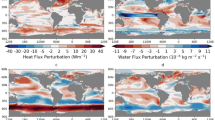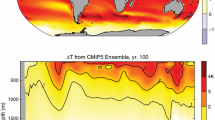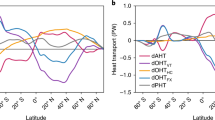Abstract
Assessments of the impacts of uncertainties in parameters on mean climate and climate change in complex climate models have, to date, largely focussed on perturbations to parameters in the atmosphere component of the model. Here we expand on a previously published study which found the global impacts of perturbed ocean parameters on the rate of transient climate change to be small compared to perturbed atmosphere parameters. By separating the climate-change-induced ocean vertical heat transport in each perturbed member into components associated with the resolved flow and each parameterisation scheme, we show that variations in global mean heat uptake in different perturbed versions are an order of magnitude smaller than the average heat uptake. The lack of impact of the perturbations is attributed to (1) the relatively small impact of the perturbation on the direct vertical heat transport associated with the perturbed process and (2) a compensation between those direct changes and indirect changes in heat transport from other processes. Interactions between processes and changes appear to combine in complex ways to limit ensemble spread and uncertainty in the rate of warming. We also investigate regional impacts of the perturbations that may be important for climate change predictions. We find variations across the ensemble that are significant when measured against natural variability. In terms of the experimental set-up used here (models without flux adjustments) we conclude that perturbed physics ensembles with ocean parameter perturbations are an important component of any probabilistic estimate of future climate change, despite the low spread in global mean quantities. Hence, careful consideration should be given to assessing uncertainty in ocean processes in future probabilistic assessments of regional climate change.










Similar content being viewed by others
References
Allan RJ, Ansell TJ (2006) A new globally complete monthly historical mean sea level pressure data set (HadSLP2): 1850–2004. J Clim 19(22):5816–5842. doi:10.1175/JCLI3937.1
Barkstrom BJ (1984) The earth radiation budget experiment (ERBE). Bull Am Meteorol Soc 65(11):1170–1185 10.1175/1520-0477(1984)065<1170:TERBE>2.0.CO;2
Barnett TP, Pierce DW, AchutaRao KM, Gleckler PJ, Santer BD, Gregory JM, Washington WM (2005) Penetration of human-induced warming into the world’s oceans. Science 309(5732):284–287. doi:10.1126/science.1112418
Bryan F (1987) Parameter sensitivity of primitive equation ocean general circulation models. J Phys Oceanogr 17:970–985 10.1175/1520-0485(1987)017<0970:PSOPEO>2.0.CO;2
Bryden HL, Longworth HR, Cunningham SA (2005) Slowing of the Atlantic meridional overturning circulation at 25 N. Nature 438:655–657. doi:10.1038/nature04385
Cess RD, Potter GL, Blanchett JP, Boer GJ, DelGenio AD, Deque M, Dymnikov V, Galin V, Gates WL, Ghan SJ, Kiehl JT, Lacis AA, LeTruet H, Li ZX, Liang XZ, McAveney BJ, Meleshko VP, Mitchell JFB, Morcrette JJ, Randall DA, Rikus L, Roeckner E, Royer JF, Schlese U, Sheinin DA, Slingo A, Sokolov AP, Taylor KE, Washington WM, Wetherald RT, Yagai I, Zhang MH (1990) Intercomparison and interpretation of climate feedback processes in 19 atmospheric general-circulation models. J Of Geophys Research-Atmospheres 95(D10):16601–16615. doi:10.1029/JD095iD10p16601
Challenor PG, Hankin RKS, Marsh R (2006) Towards the probability of rapid climate change. In: Schellnhuber HJ, Cramer W, Nakicenovic N, Wigley T, Yohe G (eds) Avoiding dangerous climate change. Cambridge University Press, London, pp 55–63
Collins M, Booth B, Harris G, Murphy J, Sexton D, Webb M (2006) Towards quantifying uncertainty in transient climate change. Clim Dyn 27:127–147. doi:10.1007/s00382-006-0121-0
Collins M, Brierley CM, MacVean M, Booth BBB, Harris GR (2007) The sensitivity of the rate of transient climate change to ocean physics perturbations. J Clim 20(10):2315–2320. doi:10.1175/JCLI4116.1
Cubasch U, Meehl GA, Boer GJ, Stouffer RJ, Dix M, Noda A, Senior CA, Raper S, Yap KS (2001) climate change 2001: the scientific basis. Contribution of working group I to the third assessment report of the intergovernmental panel on climate change. In: Houghton JT, Ding Y, Griggs DJ, Noguer M, van der Linden PJ, Dai X, Maskell K, Johnson CA (eds) Projections of future climate change, vol Chap. 9. Cambridge University Press, London, pp 525–582
Cunningham SA, Alderson SG, King BA, Brandon MA (2003) Transport and variability of the Antarctic circumpolar current in the drake passage. J Geophys Res 108(C5):8084. doi:10.1029/2001JC001147
Dalan F, Stone PH, Sokolov AP (2005a) Sensitivity of the ocean’s climate to diapycnal diffusivity in an EMIC. Part II: global warming scenario. J Clim 18(13):2482–2496. doi:10.1175/JCLI3412.1
Dalan F, Stone PH, Kamenkovich IV, Scott JR (2005b) Sensitivity of the ocean’s climate to diapycnal diffusivity in an EMIC. Part I: equilibrium state. J Clim 18(13):2460–2481. doi:10.1175/JCLI3411.1
Forest CE, Stone PH, Sokolov AP, Allen MR, Webster MD (2002) Quantifying uncertainties in climate system properties with the use of recent climate observations. Science 295(January):113–117. doi:10.1126/science.1064419
Gent PR, McWilliams JC (1990) Isopycnal Mixing in ocean circulation models. J Phys Oceanogr 20(January):150–155 10.1175/1520-0485(1990)020<0150:IMIOCM>2.0.CO;2
Gnanadesikan A, Slater RD, Swathi PS, Vallis GK (2005) The energetics of ocean heat transport. J Clim 18(14):2604–2616. doi:10.1175/JCLI3436.1
Gordon C, Cooper C, Senior CA, Banks H, Gregory JM, Johns TC, Mitchell JFB, Wood RA (2000) The simulation of SST, sea ice extents and ocean heat transports in a version of the Hadley Centre coupled model without flux adjustments. Clim Dyn 16:147–168. doi:10.1007/s003820050010
Gregory JM (2000) Vertical heat transports in the ocean and their effect on time-dependent climate change. Clim Dyn 16:501–515. doi:10.1007/s003820000059
Gregory JM, Mitchell JFB (1997) The climate response to CO2 of the Hadley centre coupled AOGCM with and without flux adjustment. Geophys Res Lett 24(15):1943–1946
Gregory JM, Dixon KW, Stouffer RJ, Weaver AJ, Driesschaert E, Eby M, Fichefet T, Hasumi H, Hu A, Jungclaus JH, Kamenkovich IV, Levermann A, Montoya M, Murakami S, Nawrath S, Oka A, Sokolov AP, Thorpe RB (2005) A model intercomparison of changes in the Atlantic thermohaline circulation in response to increasing atmospheric CO2 concentration. Geophys Res Lett 32(12). doi:10.1029/2005GL023209
Gregory JM, Lowe JA, Tett SFB (2006) Simulated Global-mean sea level changes over the last half-millennium. J Clim 19:4576–4591. doi:10.1175/JCLI3881.1
Hansen J, Ruedy R, Glascoe J, Sato M (1999) GISS analysis of surface temperature changes. J Geophys Res 104:30997–31022. Data available from http://data.giss.nasa.gov/gistemp/. doi:10.1029/1999JD900835
Hargreaves JC, Annan JD, Edwards NR, Marsh R (2004) An efficient climate forecasting method using an intermediate complexity Earth System Model and the ensemble Kalman filter. Clim Dyn 23(7–8):745–760. doi:10.1007/s00382-004-0471-4
Harris GR, Sexton DMH, Booth BBB, Collins M, Murphy JM, Webb MJ (2006) Frequency distributions of transient regional climate change from perturbed physics ensembles of general circulation model simulations. Clim Dyn 27:357–375. doi:10.1007/s00382-006-0142-8
Huang BY, Stone PH, Sokolov AP, Kamenkovich IV (2003a) Ocean heat uptake in transient climate change: Mechanisms and uncertainty due to subgrid-scale eddy mixing. J Clim 16(20):3344–3356 10.1175/1520-0442(2003)016<3344:OHUITC>2.0.CO;2
Huang BY, Stone PH, Hill C (2003b) Sensitivities of deep-ocean heat uptake and heat content to surface fluxes and subgrid-scale parameters in an ocean general circulation model with idealized geometry. J Of Geophys Research-Oceans 108(C1):3015. doi:10.1029/2001JC001218
Jones PD, New M, Parker DE, Martin S, Rigor IG (1999) Surface air temperature and its variations over the last 150 years. Rev Geophys 37:173–199. doi:10.1029/1999RG900002
Kraus EB, Turner JS (1967) A one-dimensional model of the seasonal thermocline II. the general theory and its consequences. Tellus 19(1):98–105
Legates DR, Willmott CJ (1990) Mean seasonal and spatial variability in global surface air-temperature. Theor Appl Climatol 41:11–21. doi:10.1007/BF00866198
Levitus S, Boyer T (1994) World Ocean Atlas. U.S. Department of Commerce, NOAA Atlas NESDIS, Washington, D.C
Marotzke J, Stone P (1995) Atmospheric transports, the thermohaline circulation, and flux adjustments in a simple coupled model. J Phys Oceanogr 25:1350–1364 10.1175/1520-0485(1995)025<1350:ATTTCA>2.0.CO;2
Meehl GA, Stocker TF, Collins WD, Friedlingstein P, Gaye AT, Gregory JM, Kitoh A, Knutti R, Murphy JM, Noda A, Raper SCB, Watterson IG, Weaver AJ, Zhao Z-C (2007) Climate change 2007: the physical science basis. Contribution of working group I to the fourth assessment report of the intergovernmental panel on climate change. Chap. Global Climate Projections. Cambridge University Press, Cambridge pp 747–845
Murphy JM, Sexton DMH, Barnett DN, Jones GS, Webb MJ, Collins M, Stainforth DA (2004) Quantification of modelling uncertainties in a large ensemble of climate change simulations. Nature 430:768–772. doi:10.1038/nature02771
Murphy JM, Booth BBB, Collins M, Harris GR, Sexton D, Webb M (2007) A methodology for probabilistic predictions of regional climate change from perturbed physics ensembles. Philos Trans R Soc A 365:1993–2028. doi:10.1098/rsta.2007.2077
Pacanowski RC, Philander SGH (1981) Parameterization of vertical mixing in numerical models of tropical oceans. J Phys Oceanogr 11:1443–1451
Peters H, Gregg MC, Toole JM (1988) On the parameterization of equatorial turbulence. J Geophys Res (Oceans) 93(C2):1199–1218
Randall DA, Wood RA, Bony S, Colman R, Fichefet T, Fyfe J, Kattsov V, Pitman A, Shukla J, Srinivasan J, Stouffer RJ, Sumi A, Taylor KE (2007) Climate Change 2007: The Physical Science Basis. Contribution of Working Group I to the Fourth Assessment Report of the Intergovernmental Panel on Climate Change. Chap. Climate Models and Their Evaluation. Cambridge University Press, Cambridge pp 589–662
Rayner NA, DE Parker , Horton EB, Folland CK, Alexander LV, Rowell DP, Kent EC, Kaplan A (2003) Global analyses of sea surface temperature, sea ice, and night marine air temperature since the late nineteenth century. J Geophys Res 108(D14):4407. doi:10.1029/2002JD002670
Russell JL, Stouffer RJ, Dixon KW (2006) Intercomparison of the Southern Ocean circulation in IPCC coupled model control simulations. J Clim 19(18):4560–4575. doi:10.1175/JCLI3869.1
Schmitz WJ (1996) On the World Ocean circulation: volume I. Some global features/North Atlantic circulation. Technical Report WHOI-96-03. Woods Hole Oceangraphic Institution
Stainforth DA, Aina T, Christensen C, Collins M, Frame DJ, Kettleborough JA, Knight S, Martin A, Murphy J, Piani C, Sexton D, Smith LA, Spicer RA, Thorpe AJ, Webb MJ, Allen MR (2005) Uncertainty in predictions of the climate response to rising levels of greenhouse gases. Nature 433(7024):403–406. doi:10.1038/nature03301
Stouffer RJ, Manabe S (2003) Equilibrium response of thermohaline circulation to large changes in atmospheric CO2 concentration. Clim Dyn 20(7):759–773. doi:10.1007/s00382-002-0302-4
Taylor KE (2001) Summarizing multiple aspects of model performance in a single diagram. J Geophys Res 106(D7):7183–7192. doi:10.1029/2000JD900719
Top500 org (2004) http://www.top500.org/list/2004/11/100
Valcke S, Redler R (2006) OASIS4 user guide. Tech Rep TR/CMGC/00-10. CERFACS
Webb MJ, Senior CA, Sexton DMH, Ingram WJ, Williams KD, Ringer MA, McAvaney BJ, Colman R, Soden BJ, Gudgel R, Knutson T, Emori S, Ogura T, Tsushima Y, Li B, Androva N, Musat I, Bony S, Taylor KE (2006) On the contribution of local feedback mechanisms to the range of climate sensitivity in GCM ensembles. Clim Dyn 27:17–38. doi:10.1007/s00382-006-0111-2
Whitworth T, Petersen RG (1985) Volume transport of the Antarctic circumpolar current from bottom pressure measurements. J Phys Oceanogr 15:810–816 10.1175/1520-0485(1985)015<0810:VTOTAC>2.0.CO;2
Wigley TML, Raper SCB (2001) Interpretation of high projections for global-mean warming. Science 293(5529):451–454. doi:10.1126/science.1061604
Xie P, Arkin PA (1996) Analyses of global monthly precipitation using gauge observations, satellite estimates, and numerical model predictions. J Clim 9:840–858 10.1175/1520-0442(1996)009<0840:AOGMPU>2.0.CO;2
Author information
Authors and Affiliations
Corresponding author
Appendix
Appendix
Table 3
Rights and permissions
About this article
Cite this article
Brierley, C.M., Collins, M. & Thorpe, A.J. The impact of perturbations to ocean-model parameters on climate and climate change in a coupled model. Clim Dyn 34, 325–343 (2010). https://doi.org/10.1007/s00382-008-0486-3
Received:
Accepted:
Published:
Issue Date:
DOI: https://doi.org/10.1007/s00382-008-0486-3




